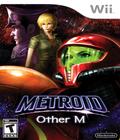Samus is back.
For everyone out there who considers the 2-D Metroid games to be the "authentic" experience, well, Nintendo has heard your pleas. And you know what? It would seem that the Big N agrees with every one of you.
We just finished playing the first hour of Metroid: Other M on the Wii and while it certainly changes up the formula a bit, the game wears its old-school roots like a badge of honor. As far as Metroid: Other M is concerned, the Prime series is more or less an alternate timeline. This is the real Metroid.
If there was any doubt about the game's inspiration, it is quickly dismissed as soon as the opening cinema pops up on screen. Old school gamers (and coinsurers of the Wii's virtual console) will immediately recognize the opening sequence as the ending cinematic of Super Metroid. Gone are the 16-bit pixels, replaced with lovingly rendered (and fully voiced) visuals. Sure, Samus looks a bit anorexic, but everything else was spot-on.
Once the cinema ended, the game rolled over into a brief tutorial that introduced us to the new controls. Metroid: Other M uses a modified "NES" layout, where most control is implemented by holding the Wiimote on its side. The pointer is used whenever you want to switch to first-person view to look around, but aside from that, it's all old-school d-pad action. No Nunchuk and no classic controller.
Visually, the game is part of the 2.5-D resurgence. Everything is rendered in 3-D, but movement is usually limited to a 2-D plane with just a bit of depth. The result is a surprisingly tight control scheme that harkens back to the Super NES. Your blaster is auto-aiming, which takes a little of getting used to, but once you wrap your head around that fact, things seem to flow naturally.
Samus can switch into first-person view at any time just by pointing the Wiimote at the screen. While in first person, you're limited to looking and shooting (no moving). The idea here is that you'll use the first-person mode for scanning the environment for clues and fighting off major enemies. You can use the standard blaster while in first-person mode as well as using your missiles. Missiles are great for taking out enemy spawn points.
After the initial training bit, the plot moved forward an indeterminate amount of time, though because the game features the character of General Adam Malkovich, we know it occurs sometime before Metroid Fusion. As Samus' former commander in the Galactic Federation, Malkovich appears to play a prominent role in Metroid: Other M. One of the story flashbacks revealed during our playthrough hinted that Samus and Malkovich may have been romantically involved in the past and that is what led to her leaving the service and taking up the life of a freelance bounty hunter.
Flying through deep space, still mourning the loss of the Baby Metroid, Samus is led to a derelict terraforming ship by a distress call. It is here that she runs into Malkovich and his crew, who are also there to investigate the emergency beacon. It seems an unknown entity has taken up residence and started eliminating the crew. The team's mission is to sweep the ship and search for survivors.
Sitting down with the first bit of actual gameplay, we immediately felt at home with the controls. Samus moved naturally, and combat allowed for a bit of flair. Sure, you could just jam the fire button, but it was also possible to move in close, perform a grab and then fire your weapon. The standard blaster comes equipped with a charge shot that does extra damage, although it does take a few seconds to power up.
Moving through the corridors, we faced off against the same classic critters that appeared in the beginning of the original 8-bit game. The retro nostalgia was a nice nod to the series. New players would likely overlook it, but series veterans will appreciate the little things like that. A Nintendo rep told us that longtime fans should expect quite a few references of this sort to the classic titles.
Once we hit the first checkpoint, it was time for a mini-boss fight. A large eyeball, which was surrounded by a body made up of purple beetles, attacked the group by flinging around its tentacles. Blaster shots did nothing, but a quick flip to first-person mode and a missile to the eye got its attention. After that, Malkovich's team whipped out their freeze guns and went to town. They would freeze part of the beast, and then it was up to us to lock on and blast the frozen bit with a missile. Flipping between third- and first-person view in the heat of battle was disconcerting at first, but the learning curve was quickly overcome since it really is just a flick of the wrist.
After the fight, we were tasked with restoring power to the station and given access to bombs. Based on the little bit we saw, there will be plenty of excuses for Samus to roll around in ball form (not the least of which is finding hidden items) as well as use her bombs. And yes, the classic bomb jump is fully intact. If your timing is right, you can blast Samus to some decent heights.
Restoring power was a straightforward sequence that emphasized the exploration aspect of the game. It is obvious that the developers intend to have you looking around as much as possible.
With the power restored, it was back to the rendezvous room for a mission update and then … blackness. Just as quickly as it had begun, the demo was over. The initial experience was a bit linear, but if prior games are any indication, things should open up a bit as you explore more of the ship. The inclusion of the bomb jump also brings to mind the possibility of sequence breaking. A popular pastime among Metroid fans, sequence breaking involves using standard power-ups to make your way to areas to which you're not supposed to have access at that point in the game. It's a way for the truly hardcore to challenge themselves.
In addition to the control tweaks, the only other major difference between Metroid: Other M and the classic style of play is how energy and missiles refills are handled. Rather than being drops from defeated enemies, Samus can now recharge at save points as well as simply by holding up the Wiimote and pressing a button. The only catch to the Wiimote charge is that it only refills up to 99 energy. If you have spare energy tanks, you can't recharge those on the go; you need to do it at a save station. While the instant recharge will be really useful at the beginning of the game, in the latter half, we would expect it to be a move of last resort.
With four months to go, Metroid: Other M is in the final legs of its development, and if the demo is any indication, this is the game that Metroid Prime should have been. We can't wait to get our grubby hands on a final disc. If Nintendo bundled this demo with any other game, it would probably have the same effect on sales as Microsoft bundling the Halo: Reach beta with Halo 3: O.D.S.T.
If you have a Wii, Metroid: Other M needs to be on your radar.
More articles about Metroid: Other M











 Metroid: Other M looks at the classic franchise from a new perspective: While much of the game is reminiscent of 2-D side-scrollers, players can switch the perspective into 3-D at any time as they explore the twisting passages of a derelict space station and delve deep into a cinematic, never-before-told story of bounty hunter Samus Aran's past.
Metroid: Other M looks at the classic franchise from a new perspective: While much of the game is reminiscent of 2-D side-scrollers, players can switch the perspective into 3-D at any time as they explore the twisting passages of a derelict space station and delve deep into a cinematic, never-before-told story of bounty hunter Samus Aran's past.












